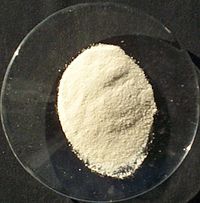
Photo from wikipedia
Abstract The hexagonal defective Sr1-xSn(OH)6 is synthesized by a scalable method and applied for photocatalytic toluene decomposition to achieve complete mineralization. The electrons-delocalized intrinsic Sr defects serve as the active… Click to show full abstract
Abstract The hexagonal defective Sr1-xSn(OH)6 is synthesized by a scalable method and applied for photocatalytic toluene decomposition to achieve complete mineralization. The electrons-delocalized intrinsic Sr defects serve as the active sites and are favorable for activation of negatively charged species (i.e. OH- and benzyl species). The crystal lattice OH- of Sr1-xSn(OH)6 system is excited by UV light and escaped with H2O formation by binding with H+ to form secondary hydroxyl defects. The electrons-localized hydroxyl defects contribute directly to the sustained intermediate activation and efficient photocatalytic toluene mineralization. The toluene mineralization rate of Sr1-xSn(OH)6 is influenced by the surface concentration of intrinsic Sr defects adjusted by synthesis temperature. After systematic optimization, the SSOH-80-4/SSOH-110-4 (Sr1-xSn(OH)6 prepared at 80/110 oC for 4 hours) with surface Sr concentration around 71.0% is found to exhibit most excellent capability for complete toluene oxidation, resulting the highest degradation rate of 73.04% (SSOH-110-4) and mineralization rate of 63.79% (SSOH-80-4). Furthermore, the toluene degradation stability is still maintained after long-term (300 min) irradiation. The reaction pathway of the toluene photooxidation over the Sr1-xSn(OH)6 is examined by in-situ DRFTS, which reveals that the benzyl alcohol, benzaldehyde and benzoic acid species were primary intermediate products in toluene conversion. The accumulation of benzoic acid is conducive to be decomposed and generate CO2 for complete mineralization. This work highlights the significance of light-induced surface defects in photocatalyst development and reaction mechanism understanding, which also is universal for other photocatalytic systems.
Journal Title: Chemical Engineering Journal
Year Published: 2022
Link to full text (if available)
Share on Social Media: Sign Up to like & get
recommendations!